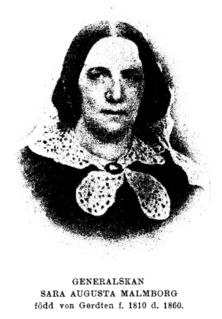
Christina Nilsson, Countess de Casa Miranda, was a Swedish operatic soprano. She possessed a bel canto technique and was considered a rival to the Victorian era's most famous diva, Adelina Patti. Nilsson became a member of the Royal Swedish Academy of Music in 1869.
The Royal Academies are independent organisations, founded on Royal command, that act to promote the arts, culture, and science in Sweden. The Swedish Academy and Academy of Sciences are also responsible for the selection of Nobel Prize laureates in Literature, Physics, Chemistry, and the Prize in Economic Sciences. Also included in the Royal Academies are three scientific societies that were granted Royal Charters during the 18th century.

Marie Louise Marcadet née Baptiste was a Swedish opera singer and a dramatic stage actress of French origin. She was ative in the Royal Swedish Opera as a singer, and in the Royal Dramatic Theatre and the French Theater of Gustav III as an actress. She was a member of the Royal Swedish Academy of Music from 1795.
Justina Kristina Casagli née Wässelius was a Swedish opera singer. She was internationally famous and active in Italy and Germany. She was a member of the Royal Swedish Academy of Music.
Margareta Hedvig Alströmer, as married Cronstedt af Fullerö, was a Swedish painter and concert singer. She was a member of the Royal Swedish Academy of Arts and of the Royal Swedish Academy of Music.

Sofia Franziska Stading was a Swedish opera singer of German origin. She is referred to as one of the more notable opera singers in Sweden during the Gustavian era. She was a Hovsångare and member of the Royal Swedish Academy of Music from 1788.
Emilie Augusta Kristina Hammarskjöld, née Holmberg, was a Swedish born, American composer, singer, pianist, music teacher and organist.

JulieMathilda Berwald was a Swedish concert and opera singer.

Johanna Carolina Ulrika von Schoultz was a Finnish-Swedish opera singer. She was a member of the Royal Swedish Academy of Music. She is counted as the second female Scandinavian opera singer to have performed in Southern Europe.
Brita Catharina Lidbeck, also Brita Catharina Munck af Rosenschöld was a Swedish Dilettante concert singer. She was a member of the Royal Swedish Academy of Music.

Anna Sofia Sevelin née Thunberg was a Swedish opera singer (alto). She was a Hovsångare and a member of the Royal Swedish Academy of Arts.
The titles Hovsångare for men and Hovsångerska for women are awarded by the Swedish monarch to a singer who, by their vocal art, has contributed to the international standing of Swedish singing. The formal title was introduced by King Gustav III of Sweden in 1773, with the first recipients being Elisabeth Olin and Carl Stenborg. The position as such, however, dates back to the 17th century, when Anne Chabanceau de La Barre and Joseph Chabanceau de La Barre were singers at the court of Queen Christina of Sweden.
Mathilda Grabow, was a Swedish opera singer (soprano). She was a court singer (Hovsångare) (1886) and a member of the Royal Swedish Academy of Music (1895) and was given Litteris et Artibus (1895).

Caroline Johanna Lovisa Ridderstolpe, née Kolbe was a Swedish composer and singer.

Dagmar Möller, born Dagmar Henriette Bosse, was a Swedish singer (soprano) and vocal pedagogue. She was the dedicatee of Edvard Grieg's song cycle Haugtussa and took past in many theatrical productions during her musical career.

Karl Fritjof Valentin was a Swedish composer.
Alette Wilhelmine Georgine Due, née Sibbern, was a Norwegian singer and composer. She was a member of the Harmoniska Sällskapet in Stockholm, and was inducted to the Royal Swedish Academy of Music 30 December 1850. She was also the overhoffmesterinne for Queen Sophia of Norway in 1873-87.

Aron Gustaf Silfversparre, , was a Swedish baron, chamberlain and knight of the Order of the Polar Star and also a member of the Royal Swedish Academy of Music.

Sara Augusta Malmborg, née von Gertten was a Swedish singer, pianist and painter.
Daniel Erik (Eric) Næzén, was a Swedish provincial physician, engraver, composer and natural scientist. In his youth Næzén was a founder member,on 13 December 1769, of the Swedish Topographical Society in Skara alongside parish priest and naturalist Clas Bjerkander, Anders Dahl, Johan Abraham, entomologist Leonard Gyllenhaal, chemist Johan Afzelius and Olof Knös. The members reported on plant and animal life, geography, topography, historical monuments and economic life, mostly in the Västergötland area. From 1770, Næzén studied in Uppsala, where in April 1782 he gained his licentiate of medicine. He studied under Carl von Linné. In July 1782 he became a provincial physician in Umeå. As a natural scientist, he contributed entomological papers to the Academy of Sciences journals. And also for the science academy he, from 1796 until his death, made meteorological observations in Umeå. Næzén left a comprehensive collection of insects, plants and minerals. Næzén studied at the Musical Academy in 1773 and was an amateur musician and amateur composer. He was elected as member 124 of the Royal Music Academy on 18 December 1790 and by the Royal Academy of Sciences in 1793.














